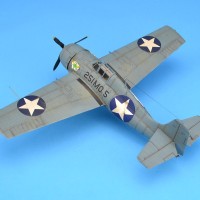Flying Leathernecks/Eyes in the Sky…1/48 Grumman F4F-3P Wildcat, VMO-251, USMC
22/2021
And my dad has finished the next one.
Hobby Boss F4F-3 (late) kit with Superscale decals. The wing walkway decals came from the sparesbox. The kit and also the Superscale star decdals for the wings were to small, took suiting decals from a Czech ROP decals sheet. Painted with a selfmixed blue-grey (Tamiya XF-18 + XF-2) and Gunze H51 Light Gull Grey. Engraved the little camera door on the right belly side. Replaced the awfully molded kit guns with plastic rods.
Build thread here
https://www.britmodeller.com/forums/index.php?/topic/235097445-flying-leatherneckseyes-in-the-sky148-grumman-f4f-3p-wildcat-vmo-251-usmc/
The F4F-3P was the first photo reconnaissance variant of the F4F fighter aircraft which had entered service with the Navy and Marine Corps in 1940. The basic fighter versions were made famous by VMF-211 defending Wake Island and later VMF-223 at Guadalcanal with the “Cactis” Air Force. The aircraft was a single seater, with non-folding wings powered by a R-1830-86 engine. It earned the distinction of being the first modern photo reconnaissance aircraft to enter service with the Marine Corps and see combat action.
The first Marine Corps F4F-3Ps were transferred from the Navy at San Diego and assigned to VMO-251 in June, 1942 after undergoing modifications at the North Island, Ca aircraft support facility. This modification involved removing the reserve fuel tank behind the pilot and installing two aerial cameras with necessary wiring and controls. The normal fighter armament was retained and put to use by VMO-251 upon arrival in the South Pacific in July, 1942. According to several records a total of 18 aircraft were converted to the 3P configuration but its not clear if all were deployed with VMO-251 in July of 1942.
The F4F-3Ps were range limited and did not deploy with external tanks so were of limited utility in supporting the initial Guadalcanal operations which began on 7 August 1942. Consequently, the aircraft were mainly used for air defense of their base at Espiritu Santo some 300 miles South of Guadalcanal. Beginning in October 1942 the longer range F4F-7P replacement aircraft began to arrive and began operations from Guadalcanal. (info taken from mcara.us)
Wikipedia info:
Marine Observation Squadron 251 (VMO-251) was commissioned December 1, 1941 at Naval Air Station North Island, California. In mid-1942 it was transferred to Tontouta, New Caledonia and then to Turtle Bay Airfield on the island of Espiritu Santo in the British-French Condominium of New Hebrides prior to the invasion of Guadalcanal. While flying the Grumman F4F Wildcat during World War II, the squadron participated in numerous Pacific campaigns including Guadalcanal, Southern Solomons, Santa Cruz, Luzon, and the Southern Philippines.
In 1943, the squadron transitioned to the F4U Corsair, and was re-designated Marine Fighter Squadron 251 (VMF-251) in February 1945. 22 F4U Corsairs from the squadron landed on Samar on 2 January 1945 as part of Marine Aircraft Group 14 (MAG-14) and continued operations in the Philippines until May 1, 1945 when it flew its last combat mission of World War II while supporting clean-up operations at Leyte.
On June 1, 1945, VMF-251 was deactivated at Samar, Philippines Island. Thirteen months later on July 1, 1946, VMF-251 was reactivated at Grosse Ile, Michigan as a ready-reserve squadron.

























Nice Hellcat Reinhard, well done weathering and decals look awesome!
A real beauty, Reinhard!
Cool Cat. More interesting than usual markings. One of Hobby Boss's better efforts.
Excellent - love the color you got with the Tamiya paints.
Well done on this beautify, Reinhard @grimreaper
Nicely done!
Very nice Wildcat! ? ?
Great looking Wildcat, nicely done!